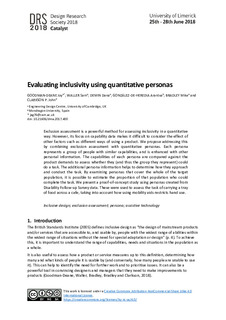Title
Evaluating inclusivity using quantitative personasAuthor (from another institution)
Version
Published version
Access
Open accessPublished at
Design Research Society. Limerick. 25-28 June, 2018 xxxPublisher
Design Research Society DRSAbstract
Exclusion assessment is a powerful method for assessing inclusivity in a quantitative way. However, its focus on capability data makes it difficult to consider the effect of other factors such as diff ... [+]
Exclusion assessment is a powerful method for assessing inclusivity in a quantitative way. However, its focus on capability data makes it difficult to consider the effect of other factors such as different ways of using a product. We propose addressing this by combining exclusion assessment with quantitative personas. Each persona represents a group of people with similar capabilities, and is enhanced with other personal information. The capabilities of each persona are compared against the product demands to assess whether they (and thus the group they represent) could do a task. The additional persona information helps to determine how they approach and conduct the task. By examining personas that cover the whole of the target population, it is possible to estimate the proportion of that population who could complete the task. We present a proof-of-concept study using personas created from Disability Follow-up Survey data. These were used to assess the task of carrying a tray of food across a cafe, taking into account how using mobility aids restricts hand use. [-]
Collections
The following license files are associated with this item:





















